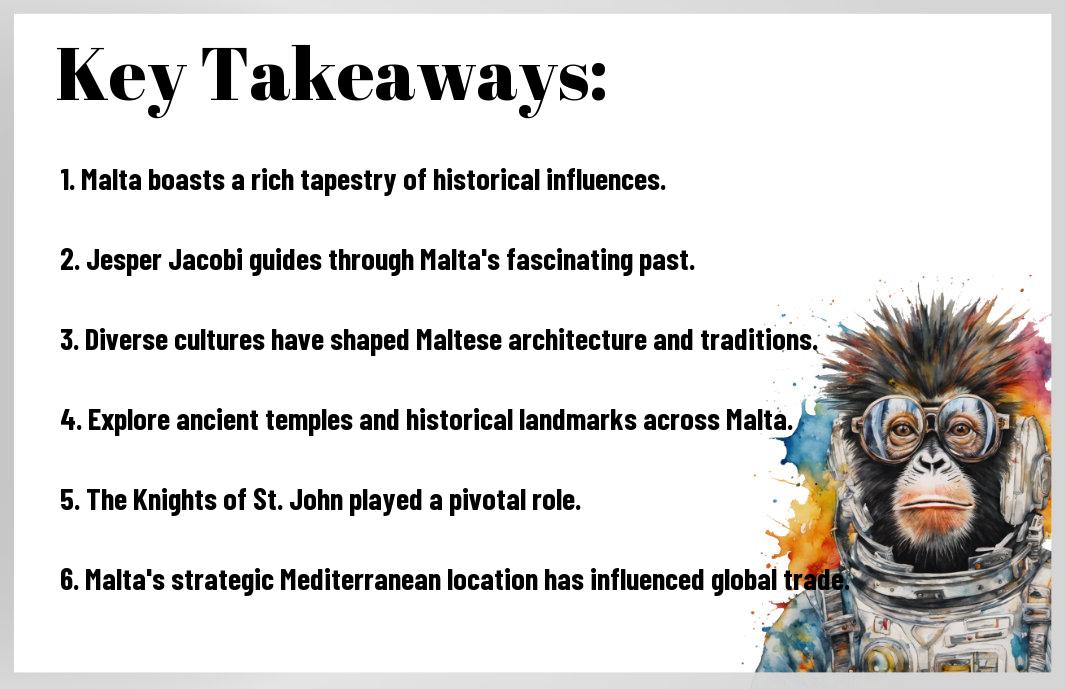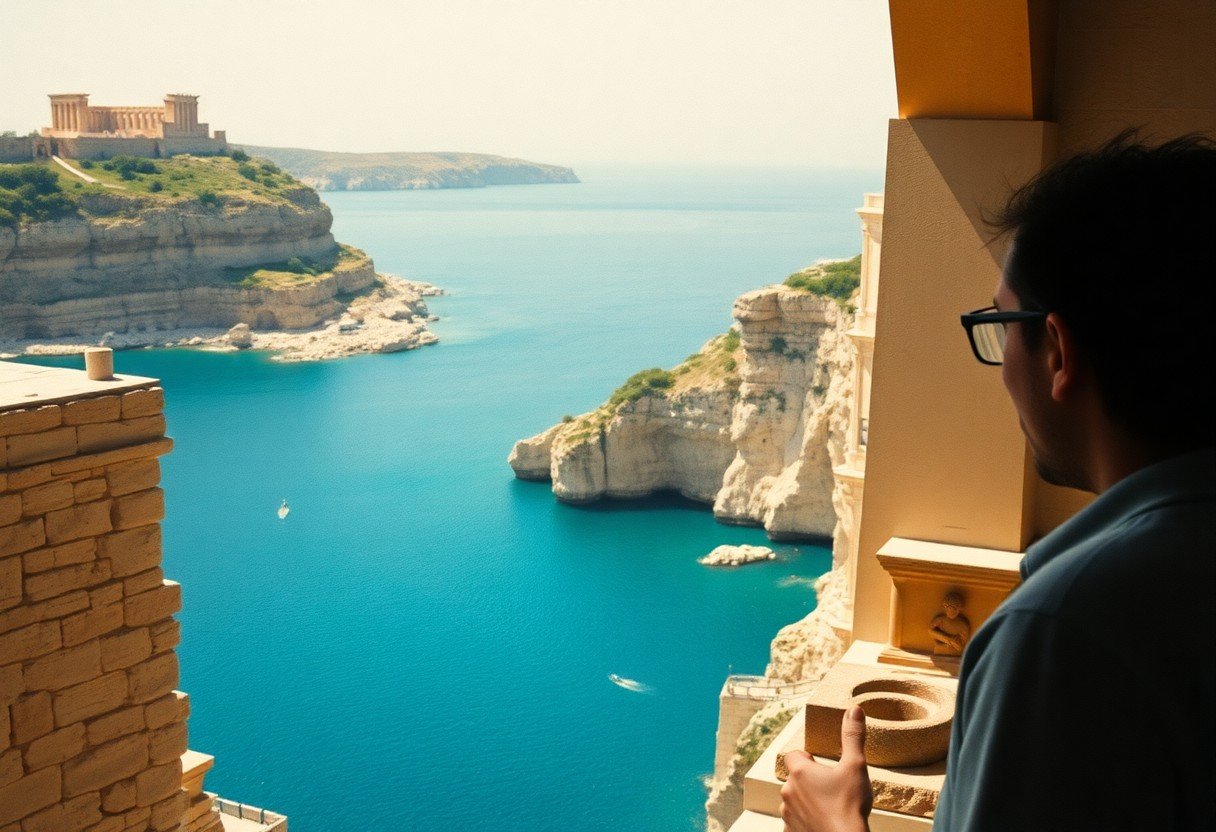Just think about stepping into the vibrant history of Malta, a small yet captivating island in the Mediterranean. You’ll discover the rich tapestry of events that have shaped its culture and identity, from ancient temples to stunning baroque architecture. Join Jesper Jacobi as he guides you through the remarkable past and present of this enchanting destination, providing insights that deepen your appreciation for Malta’s historical significance. Prepare to initiate on an enlightening journey that will leave you with a greater understanding of this Mediterranean marvel.

Malta’s Ancient Origins
Your journey into Malta’s ancient history reveals a land steeped in rich heritage and diverse influences. This Mediterranean jewel boasts traces from early human settlements, where prehistoric cultures flourished and left their mark through remarkable structures. As you research into the islands’ captivating past, you’ll discover the intricate tapestry woven by a multitude of civilizations that have called Malta home throughout the ages.
Prehistoric Temples and Megalithic Structures
Against the backdrop of Malta’s breathtaking landscapes, you can find some of the oldest freestanding structures in the world. The prehistoric temples, such as those at Ħaġar Qim and Mnajdra, reflect advanced architectural skill and hold deep spiritual significance. Visitors like you can marvel at the massive stone blocks meticulously arranged in these sites, showcasing the ingenuity of a civilization that thrived thousands of years ago.
Phoenician and Roman Influences
Maltas historical narrative continues with the powerful influence of the Phoenicians and later the Romans, who shaped the islands through trade, culture, and governance. You will see how these civilizations introduced new technologies and practices, blending with local traditions to create a unique Maltese identity that still resonates today.
Ancient Phoenicians established Malta as a vital trade hub, enriching its economy and fostering cultural exchanges. Following them, Roman rule brought infrastructure advancements, including roads and public buildings, enhancing connectivity and administration throughout the islands. The amalgamation of these influences is evident in archaeological sites and artifacts, providing you with a deeper understanding of Malta’s complex historical tapestry that continues to impress and inspire.
Medieval Malta
Some of Malta’s most fascinating historical developments took place during the medieval period, a time characterized by significant cultural, political, and social transformations. You will discover how various civilizations left their mark on the islands, shaping the unique identity of Malta that captivates visitors today. From Arab influences to the arrival of the Knights, each chapter of Malta’s medieval past contributes to its rich tapestry of history.
Arab Period and Norman Conquest
Across the 9th century, the Arab rule in Malta initiated a profound transformation of the islands’ agriculture, architecture, and linguistic traditions. This period introduced advanced irrigation techniques and the cultivation of new crops, which significantly altered local lifestyles. By the 11th century, however, Norman forces launched a conquest that would herald a new era for Malta, intertwining its future with that of Europe’s emerging powers.
Knights of St. John Era
Before the Knights of St. John arrived in 1530, Malta was a key strategic point in the Mediterranean that had drawn various rulers. Your exploration of this era will reveal how the Knights established Malta as a formidable maritime center, fortified cities, and embraced the island’s diverse cultures. Their military prowess and commitment to the defense of Christendom shaped not only the islands’ political landscape but also its architectural heritage.
Hence, the Knights of St. John transformed Malta into a bastion of strength, which you will find reflected in the stunning forts and the majestic architecture of Valletta, the capital they founded. Their influence is evident in the intricate Baroque buildings and the unique mix of cultures they fostered. As you research into their history, you will appreciate how their legacies endure, lending Malta its distinct allure today.
Cultural Heritage
Unlike many other Mediterranean destinations, Malta offers a rich tapestry of cultural heritage that reflects its diverse history. As you explore the island, you will uncover layers of influence from various civilizations, including the Romans, Arabs, and Knights of St. John. This rich past has shaped Malta’s identity, enriching your travel experience with fascinating stories, historical sites, and vibrant traditions that continue to thrive today.
Architectural Marvels
Above Malta’s sun-kissed landscapes, you will find stunning architectural marvels that showcase the island’s storied past. The capital city, Valletta, is adorned with Baroque structures, while the ancient capital, Mdina, boasts a captivating medieval ambiance. As you wander through narrow streets, the impressive forts and palaces serve as reminders of Malta’s strategic significance throughout history.
Religious Significance
Along with its historical wealth, Malta holds immense religious significance, evidenced by its numerous churches and sacred sites. Each structure tells a story of devotion and artistry, drawing you in with their breathtaking designs and intricate details.
At the heart of Malta’s religious significance is the stunning St. John’s Co-Cathedral in Valletta, a testament to the Knights of St. John’s piety and wealth. This cathedral houses magnificent artwork, including Caravaggio’s famous painting, “The Beheading of Saint John the Baptist.” As you immerse yourself in its hallowed halls, you will appreciate the devotion that shaped not only the island’s spirituality but also its architectural legacy. Additionally, the three cities of Birgu, Senglea, and Bormla reflect the deep-rooted European Catholic legacy, making Malta a remarkable destination for those seeking a connection to cultural and religious history.
Strategic Importance
Not only is Malta a stunning destination, but its strategic location in the Mediterranean has made it vital throughout history. As you explore Malta, you’ll discover how this island has served as a crossroads of cultures and armies, cementing its role in global trade and military operations. For a deeper understanding, check out Malta: A Mediterranean Marvel, which highlights its historical significance.
Naval History
Strategic naval positioning has played a key role in Malta’s rich history. You’ll find that its harbors were crucial for naval fleets, particularly during the age of exploration and trade when powerful nations sought control of the Mediterranean routes.
World War II Impact
An insight into Malta’s importance is seen during World War II, where its location made it a target of intense military operations. You will learn how it became a base for Allied forces, impacting the war profoundly.
Impact on Malta during World War II was significant, as the island endured harsh bombardments due to its strategic location. With its resilience, the Maltese spirit shone through as they supported the Allies. You’ll discover how this era not only reshaped Malta’s landscape but also solidified its identity and place in history, exemplifying the tenacity of its people.
Modern Malta
All throughout its modern history, Malta has evolved into a vibrant hub of culture, economy, and governance, making it a captivating destination for those seeking a mix of rich heritage and contemporary life. You will find a unique blend of tradition and modernity reflected in its architecture, lifestyle, and the everyday experiences of its people.
Independence and Republic
Before Malta gained independence from British rule in 1964, it experienced significant political and social transformations that shaped its identity. In 1974, Malta was declared a republic, marking a pivotal moment in its history and allowing you to trace the steps of a nation that emerged from colonial shadows to assert its own sovereignty.
Contemporary Society
Independence has brought about profound changes in Maltese society, embracing diversity and fostering economic growth. Today, you will observe a multicultural society that is both inclusive and progressive, characterized by a vibrant arts scene, a growing tech industry, and an emphasis on education.
In addition to economic advancements, Malta’s contemporary society features a blend of influences from its historical past and modern global interactions. Socially, you can engage with locals who take pride in their heritage while welcoming innovation. Festivals celebrate both traditional customs and modern cultural expressions, inviting you to experience a unique lifestyle that balances the old with the new.
Tourism and Preservation
Once again, Malta presents a unique challenge as you explore the balance between welcoming tourists and preserving its rich heritage. While the influx of visitors contributes to the economy, it also places pressure on the natural and historical sites you come to admire. Understanding this delicate relationship is imperative for ensuring that Malta remains a vibrant destination while safeguarding its cultural treasures for future generations.
Heritage Sites Management
On your journey through Malta, it’s important to recognize the initiatives in place for heritage sites management. The government, along with various organizations, works tirelessly to maintain and restore historical landmarks. By investing in conservation efforts, they ensure that you can appreciate these significant sites without jeopardizing their integrity.
Sustainable Tourism Initiatives
On navigating Malta’s attractions, you’ll be pleased to find sustainable tourism initiatives are gaining momentum. These initiatives focus on enhancing visitor experiences while promoting environmental stewardship. By dedicating your travel choices to sustainability, you can help minimize your impact on the picturesque landscapes and cultural heritage that Malta has to offer.
It’s worth noting that several programs encourage eco-friendly practices, such as guided tours that emphasize local biodiversity or initiatives to support local businesses. By participating in these sustainable options, you contribute positively to Malta’s economy while enjoying authentic experiences. Whether you choose to explore nature reserves or engage in cultural activities, your choices directly influence the preservation of the stunning Mediterranean marvel that is Malta. This commitment to sustainability ensures that you, and future visitors, can continue to enjoy Malta’s extraordinary history and beauty for years to come.
Summing up
To wrap up, exploring Malta’s rich history with Jesper Jacobi offers you an insightful journey through time. You’ll discover the island’s intriguing blend of cultures, from ancient civilizations to the Knights of St. John. Each site you visit reveals layers of heritage that shaped Malta into the enchanting Mediterranean marvel it is today. With every step, you deepen your appreciation for this unique destination, ensuring that your experience is not only educational but also profoundly enriching.




